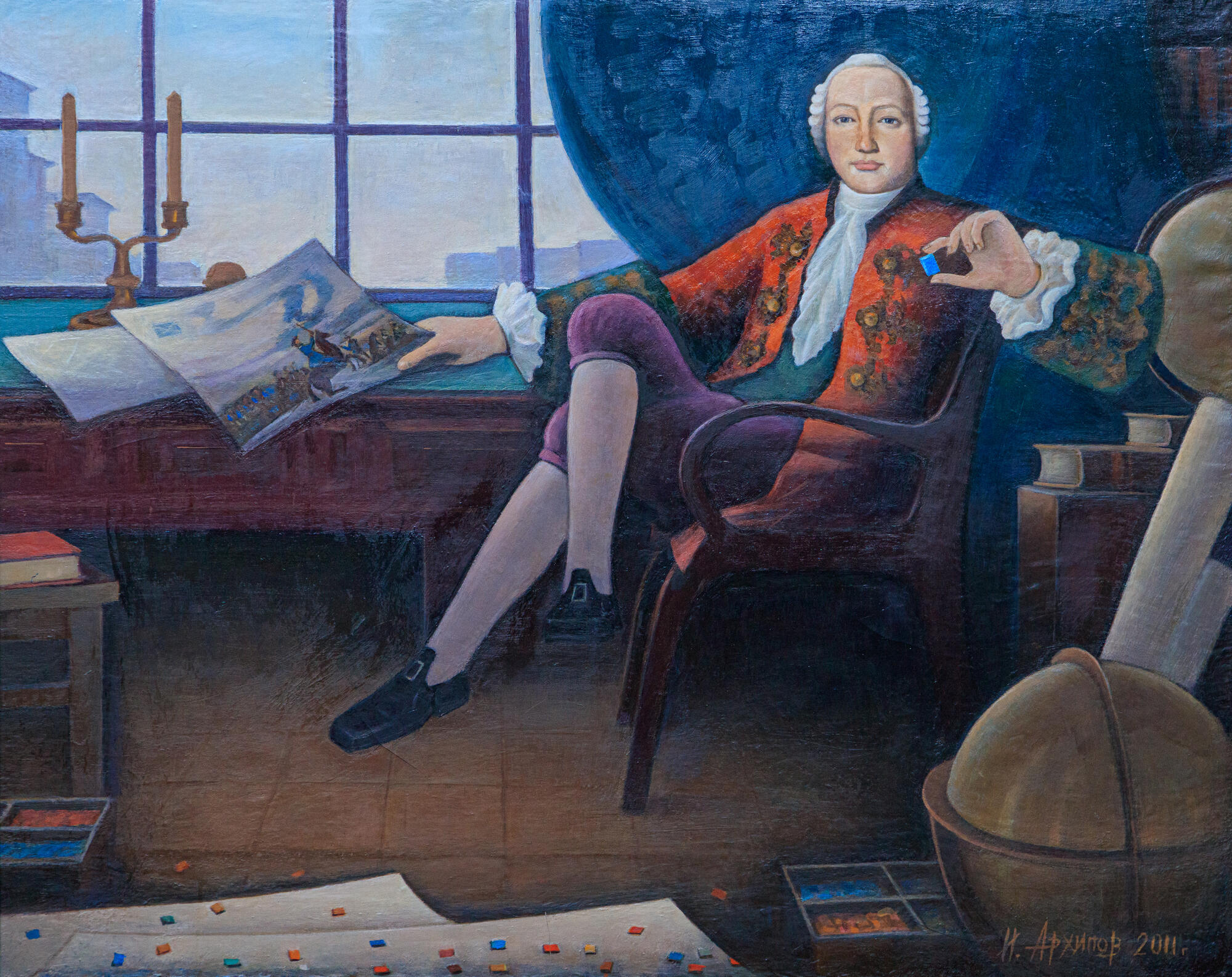The portrait of Mikhail Lomonosov in his study is one of Ivan Arkhipov’s latest works. The Arkhangelsk artist created the oil painting in 2011.
Arkhipov depicted the famous scientist, poet, artist, and thinker of the 18th century, Mikhail Lomonosov, in an armchair at his desk. In one hand Lomonosov holds a drawing, in the other he has a piece of smalt — faceted colored glass, which has been historically used in mosaics.
In 1749, Mikhail Lomonosov began his laboratory experiments at the Academy of Sciences and developed a technology of manufacturing colored glass. In total, the scientist conducted over 4,000 experiments and developed 112 basic and more than a thousand additional shades of smalt. In 1752, the Senate authorized Lomonosov by a special decree to establish a factory of colored glass. It was located in the village of Ust-Ruditsy, near Oranienbaum, where the scientist received a plot of land. In addition, he received an interest-free loan of 4,000 rubles from the state: in the 18th century, this money could buy several houses with land and shops in Moscow.
The factory in Ust-Ruditsy was founded on May 6, 1753. It consisted of three buildings. In the first building, workers cooked masses for glass, smalt and “finift” (enamel). In the second one, they processed the material and created mosaic images. The third building was a water mill, which powered the grinders.
A year later, the Ust-Ruditsy factory manufactured its first products — round and cylindrical glass beads. At that time, they were used for decorating expensive outfits, embroidery and jewelry. Lomonosov factory products were of the same quality as the famous Venetian glass. However, its main product was mosaic glass. In Lomonosov’s workshops, workers created secular and religious smalt images: they featured apostles, monarchs, landscapes, and battle scenes. These works adorned famous buildings in St. Petersburg, such as the Peter and Paul Cathedral and the vestibule of the Academy of Sciences.
Arkhipov depicted the famous scientist, poet, artist, and thinker of the 18th century, Mikhail Lomonosov, in an armchair at his desk. In one hand Lomonosov holds a drawing, in the other he has a piece of smalt — faceted colored glass, which has been historically used in mosaics.
In 1749, Mikhail Lomonosov began his laboratory experiments at the Academy of Sciences and developed a technology of manufacturing colored glass. In total, the scientist conducted over 4,000 experiments and developed 112 basic and more than a thousand additional shades of smalt. In 1752, the Senate authorized Lomonosov by a special decree to establish a factory of colored glass. It was located in the village of Ust-Ruditsy, near Oranienbaum, where the scientist received a plot of land. In addition, he received an interest-free loan of 4,000 rubles from the state: in the 18th century, this money could buy several houses with land and shops in Moscow.
The factory in Ust-Ruditsy was founded on May 6, 1753. It consisted of three buildings. In the first building, workers cooked masses for glass, smalt and “finift” (enamel). In the second one, they processed the material and created mosaic images. The third building was a water mill, which powered the grinders.
A year later, the Ust-Ruditsy factory manufactured its first products — round and cylindrical glass beads. At that time, they were used for decorating expensive outfits, embroidery and jewelry. Lomonosov factory products were of the same quality as the famous Venetian glass. However, its main product was mosaic glass. In Lomonosov’s workshops, workers created secular and religious smalt images: they featured apostles, monarchs, landscapes, and battle scenes. These works adorned famous buildings in St. Petersburg, such as the Peter and Paul Cathedral and the vestibule of the Academy of Sciences.







